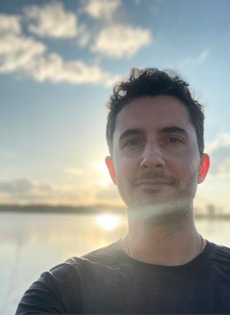
More powerful than we can possibly imagine: Star Wars and God's beloved
Wednesday, February 7, 2024
Eric A Clayton
It’s no secret that George Lucas, the creator of “Star Wars,” was an admirer of Joseph Campbell, the renown scholar of comparative mythology and religion. It’s from Campbell’s work that we get the archetypal “hero’s journey,” the path that many a protagonist must walk if they are to fulfill their destiny. As a result, Luke and Anakin Skywalker, Rey and Ahsoka Tano and so many other characters within the “Star Wars” universe find themselves walking within Campbell’s heroic footsteps.
Of the journey, Campbell writes: “A hero ventures forth from the world of common day into a region of supernatural wonder; fabulous forces are there encountered and a decisive victory is won; the hero comes back from this mysterious adventure with the power to bestow boons on [others].” (J. Campbell, “The Hero with a Thousand Faces,” p. 24)
Anakin, Luke and Rey all must leave the mundane life of sandy planets in order to become the Jedi they’re meant to be — and ultimately bring some sort of balance to the Force and the lives of each being in the galaxy.
The scenes, though, that fascinate me the most in the archetypal heroic journeys of our “Star Wars” characters are those that fall early on in what Campbell deems “the road of trials.” It’s here in the hero’s journey that the protagonist comes face-to-face with the potential and the danger of the new power they hope to wield. It’s a stage of purification, “the process of dissolving, transcending, or transmuting the infantile images of our personal past.” (J. Campbell, “The Hero with a Thousand Faces,” p. 84)
There’s something spiritually significant in this moment in any individual’s journey — heroic or otherwise. Expectations are flipped on their head, and we are forced to look within ourselves. What do we find there? Are we willing to grow and change in order to meet the needs of the moment?
In the original “Star Wars” trilogy, this moment is best encapsulated in Luke Skywalker’s journey into the dark side cave on the swamp planet, Dagobah, in Star Wars: Episode V—The Empire Strikes Back. He comes face-to-face with the image of Darth Vader, supposed evil incarnate. But in truth, Luke comes face-to-face with his own potential for darkness. When he strikes down Vader, it’s his own face he sees behind the mask. And he must reconsider: Is it really Vader’s destruction that he seeks? That will bring justice and peace to the galaxy?
“We may see reflected not only the whole picture of our present case,” Campbell writes, “but also the clue to what we must do to be saved.” Luke saw the immediate threat to his safety and that of his friends: Vader himself. But to ultimately fulfill his destiny, Luke had to wrestle with the fact that the same potential for evil lay within him as it did his father.
I love that scene on Dagobah. When Luke asks Yoda what he’ll find in the cave, Yoda’s response — “Only what you take with you” — is illustrative of our own spiritual journeys. What past shame or guilt or anger do we carry with us along our own road of trials? How might we loosen our grip on such things so as to be better able to respond to the real needs in our lives and world? To change and grow?
When I watched Star Wars: Episode VIII—The Last Jedi, I knew there was going to be some cave-like scene. The sequel trilogy, to use Lucas’ infamous words, “rhymed” with the original trilogy in such a way that it seemed inescapable.
But when we came to the scene in question — Rey’s descent into the depths of Ahch-To, her hope to uncover answers to her past and wisdom for her future — it played out all wrong. It’s just a mirror; she just sees herself. She doesn’t strike down a foe; she doesn’t relive any past battles.
She leaves confused and disappointed.
As do countless moviegoers who undoubtedly wanted to solve the mystery of Rey’s family lineage.
But here’s the thing: The more I think about that scene, the more I realize I love it. It’s spiritually revelatory. On Dagobah, Luke realized that within himself was the same weakness that tempted his father to the dark side. But looking within ourselves isn’t just an exercise in discovering darkness.
In truth, if we really believe that we are made in the image and likeness of God, of our God who is community, who rejoices in the companionship and love shared between Father, Son and Holy Spirit, then we should look at ourselves and recognize our belovedness. Our boundless potential for good.
That’s what Rey saw on Ahch-To — though she didn’t yet realize it. She saw echoed again and again the truth that she was enough. She didn’t need a fancy last name like Kenobi or Skywalker or Palpatine (though she would eventually get two out of the three). She didn’t need some epic backstory. She just needed to be herself. By claiming herself, she became who she already was—and that person was enough to defeat the darkness.
Again and again, I come back to the words of the French Jesuit priest and scientist, Pierre Teilhard de Chardin. He wrote: “The deeper I descend into myself, the more I find God at the heart of my being…the God who pursues in me the task, as endless as the whole sum of centuries, of the incarnation of his Son.” (“Pierre Teilhard de Chardin” by Ursula King, p. 50-51)
That’s what we see in Rey, in her watery climb, in those mirrors, in those echoes of her own greatness: a descent into self that reveals the presence of God’s Spirit already at work.
Because after all, when we find ourselves on the road of trials, where do we turn? To whom shall we go? To God, of course, to the living Christ dwelling within our very selves: God’s beloved.

